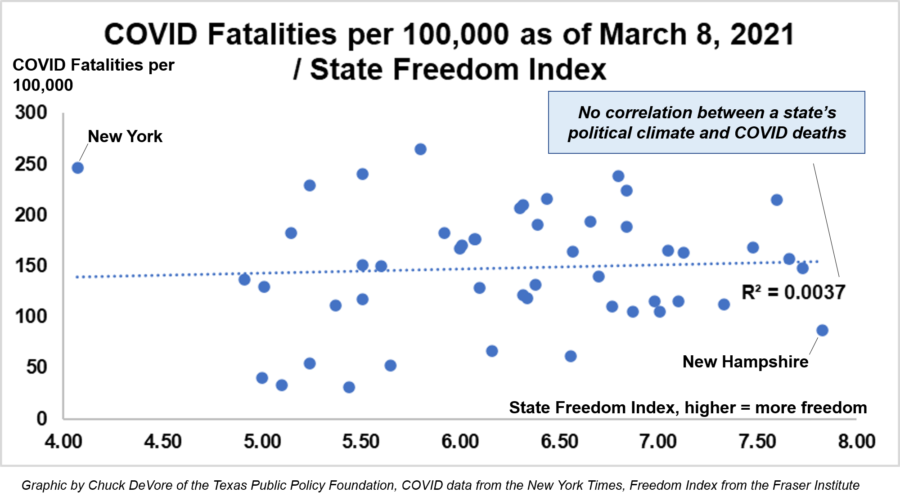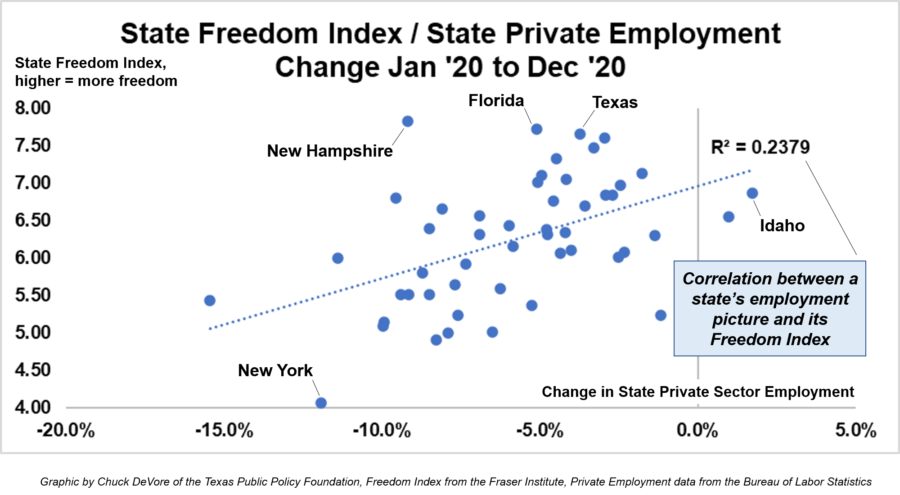The government response to COVID-19 has mostly been a failure. Theatric, yes—see New York Gov. Andrew Cuomo’s Emmy. Symbolic, yes. But there is no evidence shutdowns did anything but deepen the economic suffering, increase suicides, and prevent lifesaving medical tests and treatments.
With the exception of former President Trump’s effort to speed research, approval, and rollout of a COVID vaccine—Operation Warp Speed—and efforts to discourage the spread of the virus through border restrictions—now abandoned by President Biden, what policies can objectively be shown to have worked?
Last May, I had a piece in The Federalist that looked at state-level unemployment for the month of April, writing, “The numbers are brutal, with each bit of cold data representing people who have lost their livelihoods, seeing their plans derailed by a virus released by what appears to be sloppy lab procedures in Wuhan, China.” And then noting, “There appears to be no statistical connection between the economic pain of the nationwide shutdowns and the number of COVID-19 cases or fatalities. None. Let that sink in for a moment, given we were told we had to lock down America to ‘flatten the curve’ and save lives.” I also found a statistical connection between a state’s reliance on mass transit and a higher fatality rate.
One year on, has anything changed? What does the data say? Does anything suggest that the shutdowns were worth it?
The change in private sector employment among the states from January 2020 to December 2020, the latest month for which data is available, can be used as a proxy for the severity of government edicts to slow the spread of the virus. It represents closed restaurants and family-owned businesses, destroyed lives and life’s savings. In theory, this economic pain should have been rewarded with a lower COVID fatality rate—that’s what we were told as we obediently stayed at home.
The data shows there to be no benefit earned by the states that inflicted the largest destruction on their job base, judging by the fatality rates from COVID. Graphically, it looks like this.

Another constant feature of the corporate media’s COVID-19 coverage was that red states were killing their people. Again, the data after a year shows no correlation between a state’s level of freedom, as measured by the Fraser Institute in their annual Economic Freedom of North America survey, and COVID fatalities.

However, there is a modest correlation between economic freedom and the strength of the job market over the past year—though it is important to note that the correlation between freedom on the state level and job creation has been a long-term trend, one that COVID-19 did not change.

Digging deeper into the data, a regression analysis seeking correlations to per capita COVID-19 fatalities at the state level to five variables—use of mass transit, change in private sector employment, economic freedom, share of the population 65 and older, and the percentage of adults with obesity in 2020, finds only a weak connection (adjusted R square of 0.19). Only two variables are significant in this correlation: the share of mass transit use (P-value of 0.001) and prevalence of obesity (P-value of 0.009).
This would suggest that the virus takes its course, more or less infecting and killing people regardless of steps taken by our governments so far—with the possible exception, pending additional viral mutations—of the effort to develop and deploy effective vaccines.
Thus, with no statistically consistent difference in virus fatality outcomes between Gov. Cuomo’s New York, 11.9% drop in private sector jobs, Gov. Newsom’s California, 8.3% loss of jobs, Gov. Abbott’s Texas, 3.7% decline, and Gov. DeSantis’s Florida, 5.1% drop, it makes sense to encourage opening the economy while protecting the most vulnerable populations.
Lastly, as a crowning example of our politicians’ proclivity to reward failure, it is illuminating to see that more than 90% of the $1.9 trillion Biden stimulus is not directly related to COVID-19. Some $350 billion of the behemoth spending bill bails out the same state and local governments that inflicted the greatest damage on their own economies, realizing no measurable gain in public health.
As the Foundation for Economic Education notes, “…Biden’s bill spends more than twice as much lining the pockets of bankrupt blue states than it does actually addressing public health.”
But then, spending, not public health, is the purpose of the bill.